|
By Florida_Phil - 7 Years Ago
|
I now have a very nice Edelbrock 255 manifold. My 55 Tbird is currently running with one Holley 465 4V. I purchased a second 465 and am awaiting it's delivery. Soon, I will be mocking up the dual quad setup. This leads me into a few questions.
1. I can see the runners are a little smaller in the 255 than those in my "G" heads. Will I need to port the 255 manifold or will it work as is for a street car?
2. Should I port the adapters?
3. Should I mount the carbs forward or backward?
4. I believe I will use direct linkage. Is this best for a street car?
My 301 cu. in 292 is running perfectly. It has a moderately bumpy cam and idles at 800 rpm. The plugs are very clean with almost no discoloration. The motor is nearly new and I am running a Pertronix unit and coil. Do you think the second 4V will change my car's driveabilty? I don't want problems.
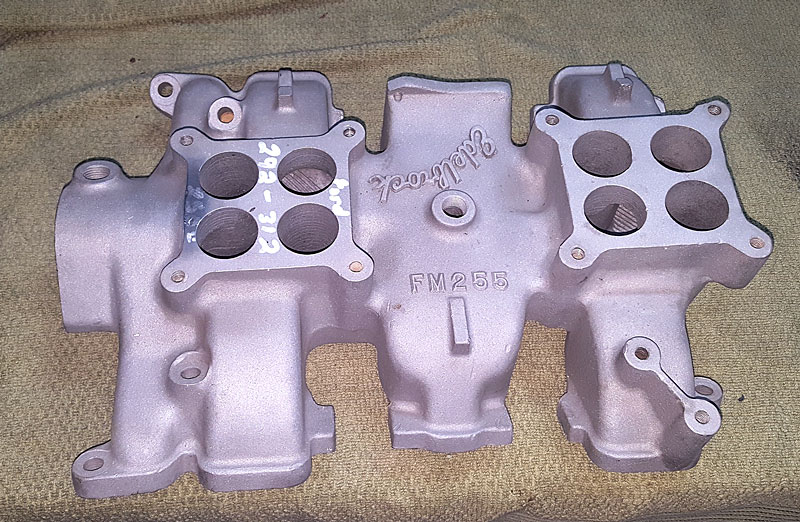
|
|
By Ted - 7 Years Ago
|
Port matching at the intake ports going to the heads and where the carb adapters bolt to the carb flanges will be beneficial. Some port work at the openings at the carb bores on the intake also helps. The engine will run okay without doing this but will have better rpm capability when the ports are worked on some.
The throttle linkage is less complicated if the carbs are mounted forward. There’s also more room (~½”) behind the carburetors if mounted forward. If running the carbs so they are facing to the rear, then you’ll need a bellcrank for the throttle so the linkage can moved over to the right side of the engine. If running both carburetors so the linkage is synchronized, then fuel distribution is expected to be the same regardless if the carbs are mounted facing forward or backwards.
For the secondaries to work as intended, the secondary diaphragm springs need to be replaced with either the long yellow or short yellow springs. When using the carbs in pairs, the carburetor signal is reduced in half which essentially means that the secondary spring tension must also be reduced in half. This is where the yellow springs come in.
As long as the carburetors are in good condition and jetted appropriately, the cylinders are expected to burn cleanly. Idle fuel mixture is going to be important here as both carburetors need the idle mixture screws set the same. You’ll find that less idle mixture adjustment per carb is required when using them in pairs versus using just a single carb.
Here’s a picture of the FM255 with the Edelbrock #1106 carb adapters. These will likely have the carbs too high on a Thunderbird engine but would work well on cars and pick ups where hood clearance is not as much an issue.
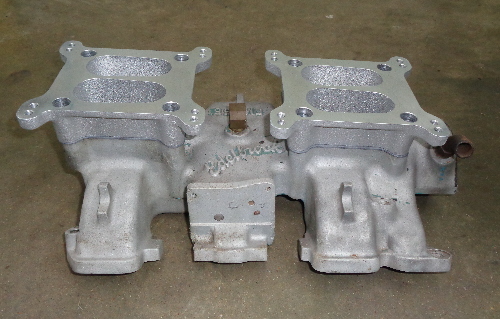
|
|
By KULTULZ - 7 Years Ago
|
A$$uming the intake carb flange bores are 1.5" as is the ECZ-B 4V intake, I remember seeing a carb adapter that had throttle bores that were 1.5" on the base while a little larger on the carb mounting side (chamfer) that would allow a later larger throttle bore carb to be mounted without have to hog the original intake. This is for the small pattern mtg.
Anyone have reference to this adapter?
|
|
By Florida_Phil - 7 Years Ago
|
Thanks for the information. Can anyone tell me what these holes are for? Can I mount a coil bracket in these holes?
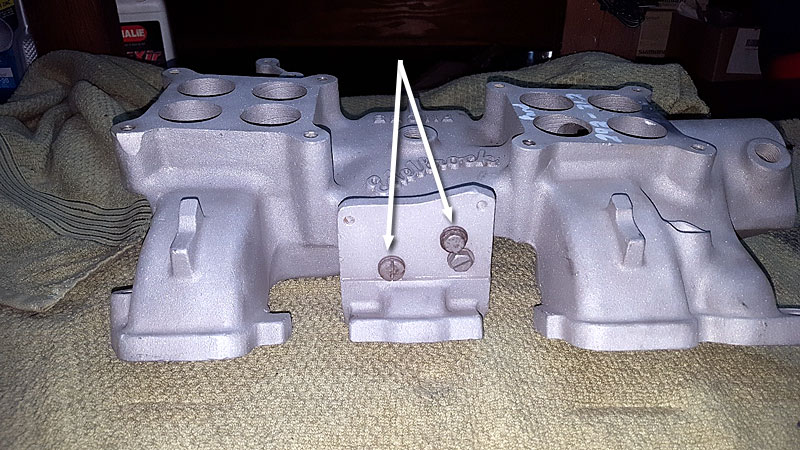
|
|
By NoShortcuts - 7 Years Ago
|
Phil. Below is an adapter available on the Speedway Motors site . . .
My copy-paste doesn't seem to work nor my importing of a Word document work-up. Ugh!
Click the link below to see the Speedway Motors web site info.
https://www.speedwaymotors.com/Holley-Edelbrock-to-Carter-WCFB-4-Barrel-Carburetor-Adapter-Plate,5551.html
![]()
![]()
Hope this helps! 
|
|
By KULTULZ - 7 Years Ago
|
|
Bore size is 1.5" on the small side and tapers to 1.685" on the large side.
Took care of the throttle bore size problem,
|
|
By KULTULZ - 7 Years Ago
|
|
Can anyone tell me what these holes are for?
Hot air choke heat source.
|
|
By KULTULZ - 7 Years Ago
|
|
https://www.holley.com/blog/post/4165_4175_carburetors/
|
|
By Joe-JDC - 7 Years Ago
|
|
The 465 cfm carb is a 4160 style, not the ones in the above link. You cannot install two 4165 style carbs on the Ed 255 manifold end to end. Joe-JDC
|
|
By KULTULZ - 7 Years Ago
|
|
The 465 cfm carb is a 4160 style, not the ones in the above link.
... whoops ... mis-read ...
I thought the OP was stating carb style, not CFM rating.
THANX for catching that ...
|
|
By Florida_Phil - 7 Years Ago
|
I'm OK without a choke in Florida. Two pumps, start it up, a minute to warm it up and I am good to go. Can't find my snow shovel. 
|
|
By Ted - 7 Years Ago
|
While the following two pictures show a pair of model 2140 Teapot carbs being used on a dual quad intake, this will give an idea of how the linkage looks when using a bellcrank so that the two carbs face the rear rather than to the front.
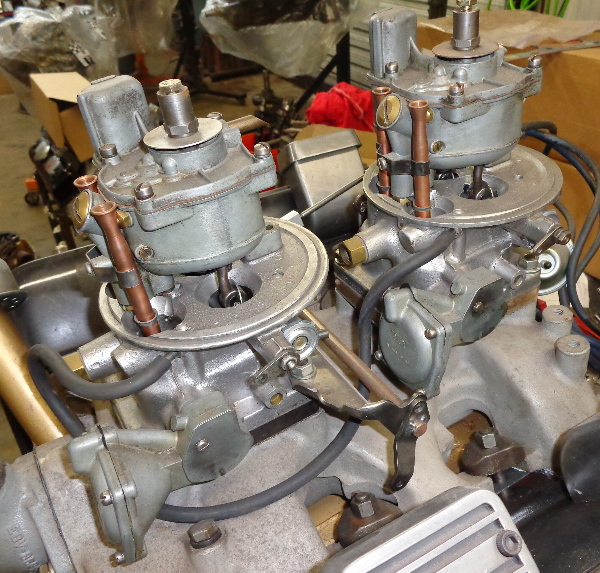
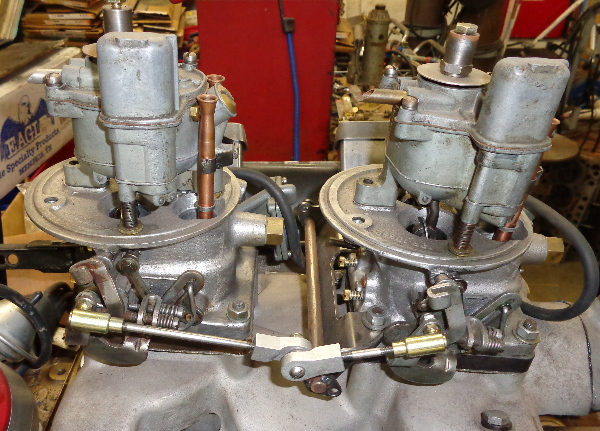
|
|
By Florida_Phil - 7 Years Ago
|
Is there any advantage to mounting the carbs backward?
|
|
By Hoosier Hurricane - 7 Years Ago
|
|
The carbs were mounted backwards on T-Birds to provide clearance at the front edge of the hood scoop opening. Probably was a response to an engineering OhOh when they discovered that the hood hit the float bowl of the front carb. The float bowl is not centered to the base of the teapot carb, so turning the carb around moved the float bowl toward the rear of the hood scoop. The crossover bellcrank in Ted's picture is a T-Bird part, the rest of the linkage is not.
|
|
By Florida_Phil - 7 Years Ago
|
I received my second Holley 1848-1 carburetor and it looks good. My FM255 manifold has been bead lasted and looks like new. I have heard some people paint cast aluminum manifolds with clear spray paint. I have never done this. Is this worth doing?
|
|
By charliemccraney - 7 Years Ago
|
I wouldn't clear the manifold.
I did it to my Blue Thunder and other aluminum parts. It looks great initially, but yellows and wears over time, not looking so great.
|
|
By oldcarmark - 7 Years Ago
|
Florida_Phil (12/21/2019)
I received my second Holley 1848-1 carburetor and it looks good. My FM255 manifold has been bead lasted and looks like new. I have heard some people paint cast aluminum manifolds with clear spray paint. I have never done this. Is this worth doing?
Is Powder Coating available as a clear Application?
|
|
By Joe-JDC - 7 Years Ago
|
|
Depending on where you are located, you might find the disc brake aluminum Caliper paint/or aluminum Wheel paint to your liking. It is high temperature resistant, stain resistant, and chemical resistant due to being used on disc calipers. I have used it on aluminum parts and it leaves a nearly identical finish, lasts well, and gasoline doesn't seem to bother the finish. I have actually used it inside an intake manifold to cover epoxy, and it is holding up well. Joe-JDC
|
|
By DryLakesRacer - 7 Years Ago
|
Florida, I have run dual quads on an Eldelbrock for 5 years with absolutely no problems. I do not have anyway near Teds experience but do have some multi carb time. I've have always ran progressive linkage and for me found the Edelbrock internal passages are just fine for normal driving. I made a Uni-Syn (Summit) adapter for my tops. I made one small adjustment after a check 2 years ago. They are a godsend. I used no rubber in my fuel and filter lines
I bought a linkage kit for a 427 Ford repo and made some of my own. Mine are set normal (not reversed) as I have a lot of room. I did not use modern Holley's so I did not have a Fitment problem. I idle off both and run on the rear. Reversed it would be just the opposite. Vacuum for the dist is off the running carb. I use the stock Ford "monkey motion" foot feed by making a shorter arm.
One of the internal choke tubes was good so I have a choke on the rear carb. Remember to tap and plug them if they are bad prior to installing the manifold. That exhaust leak noise will bug you and off it all comes to fix it. The choke is set to only slightly close but enough to sit on the first notch on the raise idle. It's off in a mile or 2 or I can "pop" the throttle and do it even before I leave the garage. I'm in So Cal and chokes are really a small convenience. Dead cold engine starts best by flooring the foot feed to squirt fuel into both ends. From then on I never touch the throttle just like a modern car.
Y-Blocks are a good looking engine made better by dual quads. I'm now a just a crusier but stick my foot in it once in a while to "clean it out". There is nothing like the sound of wide open 8 barrels running up a freeway blowing past 100 mph. Good luck and let's see some photos..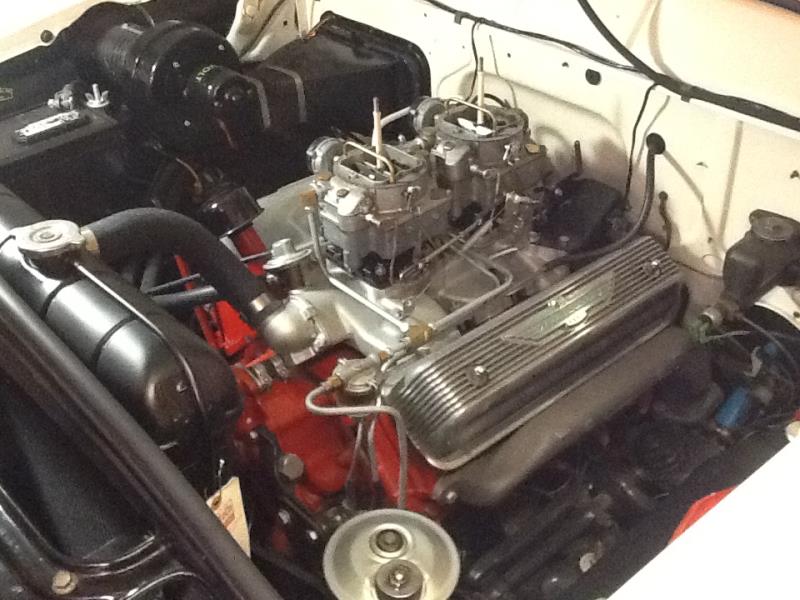
|
|
By Florida_Phil - 7 Years Ago
|
Thanks for the input. My carb adapters are on their way. So far I have a nice 255 manifold and two Holley 465s. As soon as the adapters arrive, I will lay things out and take some measurements. Hood clearance may be an issue. From what I can see in photos of other cars the Holley carbs should clear fine. I would like to run two chrome Stelling and Hellings air cleaners like the 427s had, but I'm not sure they will clear the hood. I'll also need to fabricate a coil bracket and fuel lines.
I'm still deciding if I should run direct or progressive throttle linkage. I assume driveability will be better with progressive linkage, but I may be wrong. My car runs great with one Holley now. I'll put that carb in the rear and make it my primary. Will my car drive OK on just the rear 4V? I may try both ways to see which way is better. I'm mounting my carbs forward, so changing linkage will not be a problem.
I'm going to take my time with this upgrade. I want the look and performance of two Holley's without sacrificing reliability. I had a bad experience with 3-2s, mainly due to those old 2V carbs. Hood clearance was also a major issue.
|
|
By NoShortcuts - 7 Years Ago
|
Phil. Some comments from the peanut gallery . . .
I'm intrigued that Ford seemed to be married to direct linkage on y-block and FE dual quad set-ups while GM scrubrolet seemed to be tied to the progressive linkage methodology. I don't know if that was true across other GM divisions (like Cadillac) or just scrubrolet.
My understanding is that Ford's FE factory triple set-ups used idle circuits in all three carburetors. That was so different from the thinking of most hot rod triple set-up architects who advocate eliminating the idle circuits in the end carbs and using the carbs as dumpers.
Food-for-thought from a fellow y-block hobbyist . . .
- The Edelbrock y-block FM255 intake separates the two four barrel carbs more than other Edelbrock and other aftermarket manufacturers did.
- There's ~ 8 1/2 inches between the carburetor centers.
- Each carburetor's primary throttle plates appear to be equally spaced from the four cylinders that each carb feeds.
- In using progressive linkage with the rear carb as the primary, the airflow from the rear carb primary plates to the front intake ports' branching is ~ 7 5/8 inches.
- The distance from the rear carb primary plates to the rear intake ports' branching is ~ 1 3/8 inches.
- This suggests that the rear primary carburetor's air flow will favor the rear four cylinders.
- Additionally, with progressive linkage, the front carburetor's actual opening of primary and secondary throttle plates will likely be quite limited in the vehicle's normal street and highway use.
Is progressive linkage of the carbs on this particular 2x4 intake manifold layout ideal for equal air flow to all cylinders?
Best Wishes always with what you're doing! 
|
|
By KULTULZ - 7 Years Ago
|
|
For the truly dedicated and detail-oriented, powder coating can be applied to engine parts under the hood for a truly cohesive color scheme on your car. You can have the entire chassis frame powder-coated, or you can opt for any combination of the various engine components under your hood. A car’s engine cover if there is one makes for an especially popular powder coating candidate.
From - https://www.fullblowncoatings.com/what-is-clear-powder-coating/
|
|
By KULTULZ - 7 Years Ago
|
The following is in no way disrespect for TOM EATON and his experience/knowledge.
I think the FYB 8V Systems were released for race mainly. The use of direct linkage would be advantageous in that scenario. GM used progressive on their early systems (8V and 6V) to make them more street-able. As bad as I hate to say it, GM did offer better street engines. FORD did not. If you wanted a fast FORD, you usually had to build it. That was until 1968 anyway (428CJ).
You run on the primary carb primary circuit until you want more acceleration. You use two idle circuits but only one accelerator pump for normal driving until higher RPM cut-in. That primary carb will supply sufficient fuel at low street RPM as the fuel mixture is a vapor and will be drawn to each cylinder due to a common plenum. Each cylinder will not be perfectly balanced (according to intake plenum design) but once both carbs are cut in, most everything will be good (if setup properly). I had a 67 GT-500 that when all eight opened it sounded like a shotgun.
The only way to win the argument is to install both linkage systems, tune and put on a chassis dyno.
|
|
By DryLakesRacer - 7 Years Ago
|
Since I run progressive I'd like to throw this in. When I still had my manifold off I taped of all the ports with blue masking tape and started poking holes and using my air comp and a nozzle to see if the front of the rear carb had passages to the front. I checked each one, one at a time removing the port flange tape and poking a hole and adding air at the carb plate. I didn't care how much flowed, just that it did. I was making an assumption that if there was a passage, enough would flow at idle and cruise no matter how many inches it was different from the rear. All of them showed air flow so I also assumed then I could go progressive like the 245/270 hp "C" engines. In 5 years there is no difference in plug readings. I run 45's.
Remember these engines are just "air pumps" and don't know much or care much about effiency at the lower RPM's where we normally drive them. I'm not at a drag strip. Unless your racing and using a tunnel ram type manifold you don't don't do this for a performance advantage. If I was looking for that I'd put on my Blue Thunder or a Mummert 4 barrel. I did it because it's neat looking.. After 5 years of have guys look under my big red Purolator air cleaner I've gone to individual air cleaners buy using Charlie Prices bases, Empi VW filters, and 2 7" polished aluminum pan lids for a kitchen supply store..
Dual quads on anything is always worth a second look and a smile....The 50-60's at there finest.
|
|
By Florida_Phil - 7 Years Ago
|
Thanks for the opinions. I noticed the greater plenum separation in the FM 255 manifold myself. The air compressor test is something I would not have thought of. Since my carbs will be mounted forward, it won't be difficult to try direct and progressive linkage and go with what works best. My TBird is street driven around town and to car shows. It's not a racer. I do step on it hard. I don't race because I'm sure I would grenade the T86 tranny and that's something I don't want to happen. I test mounted the carbs this afternoon and took some measurements. One of the carbs in these photos is on my car now. The second one needs cleaning up. I will be changing out the vacuum secondary tops so I can connect them. Looks awesome.
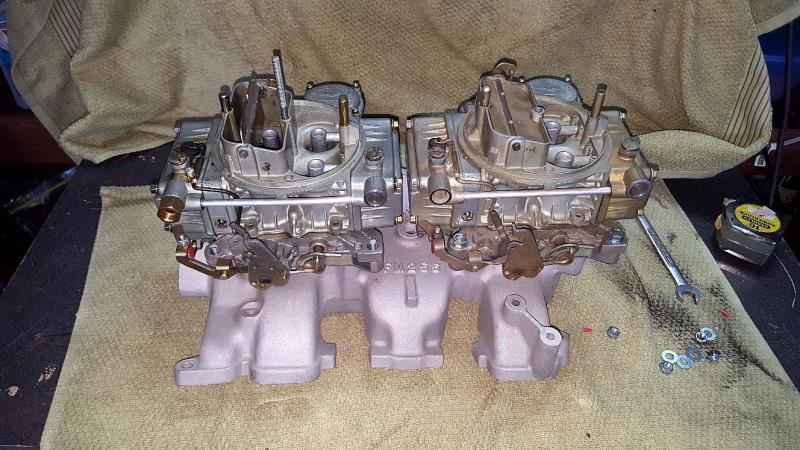
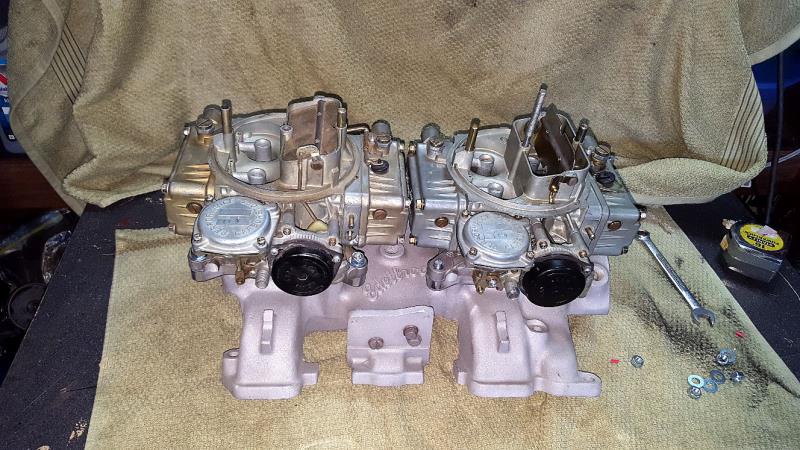
|
|
By Florida_Phil - 6 Years Ago
|
Anyone know where I can buy this or a similar part so I can connect my stock Thunderbird linkage to my dual quads?
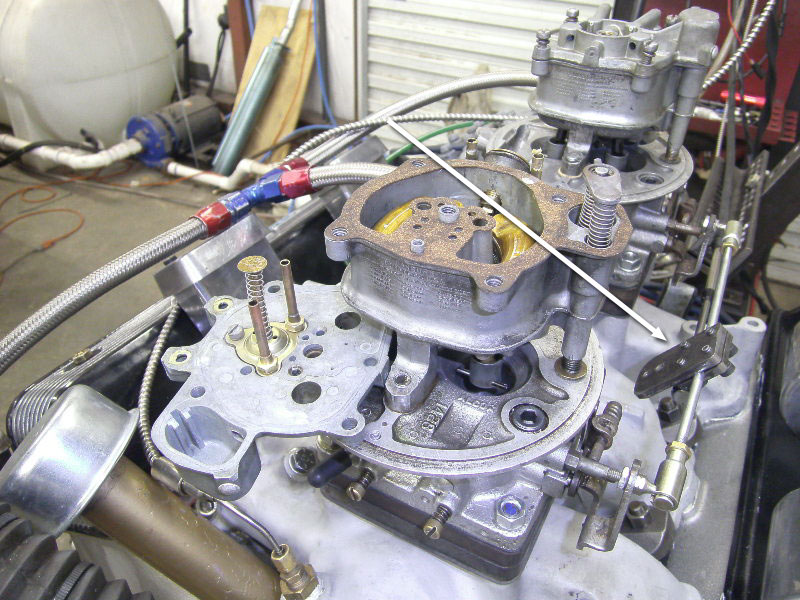
|
|
By Ted - 6 Years Ago
|
Florida_Phil (1/1/2020)
Anyone know where I can buy this or a similar part so I can connect my stock Thunderbird linkage to my dual quads? 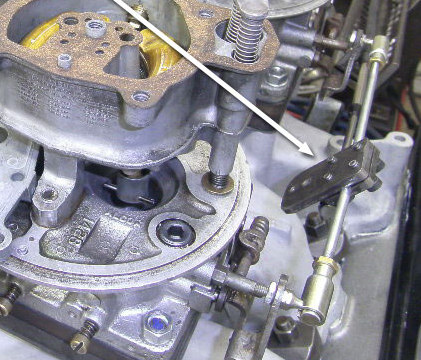
Phil. Those pieces I made for the dyno so the linkage could be easily adapted and adjusted.
|
|
By Ted - 6 Years Ago
|
The Ford Y dual quad setups had direct linkage to both carbs as supplied by the factory on both the forward facing and rear facing applications. It would be interesting to hear why that was the ultimate choice by the engineers as to whether both linkage setups were tested and the direct linkage deemed the better of the two or if the direct linkage was simply more expedient and less expensive to provide. You’ll have to keep in mind that there were several thousand dual quad equipped 1957 Fords made with the dual quad option and those all had direct linkage on the carbs.
When the FE’s came out with three deuces and dual quads, progressive linkage was used on all of those. On the FE three deuce setup, progressive linkage was a natural as the primary carb was centered on the manifold thus making fuel distribution to the front and rear of the engine much more equal. On the dual quad setups, the two carbs are facing to the rear to facilitate distributor clearance and on those setups, the front carb is the primary carb with the rear carb being in the idle position for the first third of the throttle opening. That put the primary bores on the front carburetor in the most favorable position to feed all the cylinders in normal driving. Having the carbs face rearward did mandate the use of a bell crank on the throttle linkage to move the linkage to the passenger side of the engine. This bell crank scenario is also seen on the Thunderbird Y dual quad applications where the carbs are also facing to the rear. Where the FE with dual quads had progressive linkage, the 'E' code Thunderbirds had direct linkage.
I have a dual quad FE in a ’66 Fairlane and drove it for awhile with the original progressive linkage but eventually got tired of the off idle hesitation with the progressive linkage when just driving the car around normally. I went with direct linkage on both carbs and drivability improved immediately.
On your Y setup, try it both ways and find which one you are happier with.
Here are a couple of pictures of the direct linkage on Y dual quad setups.
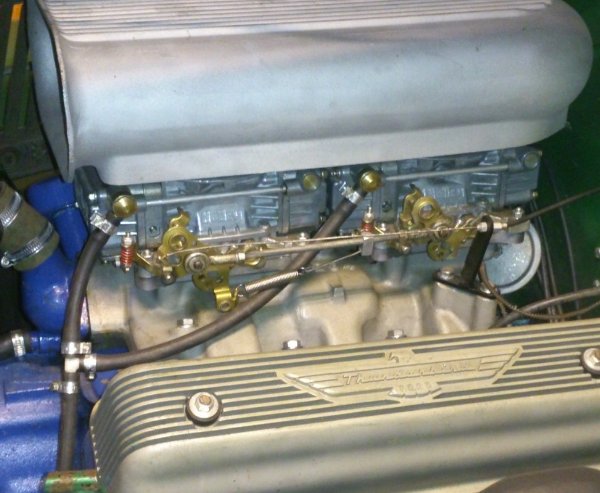
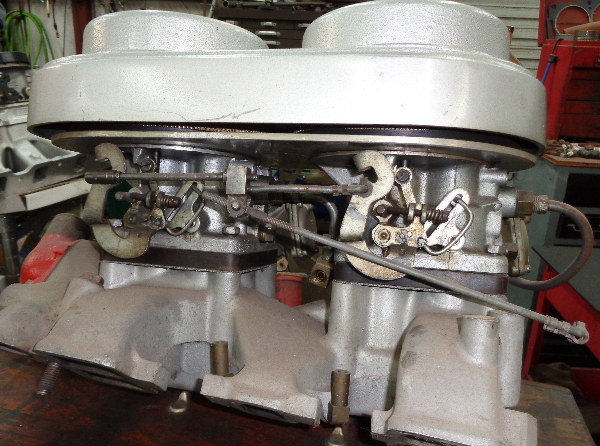 o o
|
|
By Florida_Phil - 6 Years Ago
|
I'm having a difficult time finding the part in the photo below. Lots of suppliers make a rod with ends to connect both carbs, The Thunderbird linkage requires a hole mid way. There is 8 3/4" between the carb linkage holes. Does anyone reproduce this linkage or must I fabricate it?
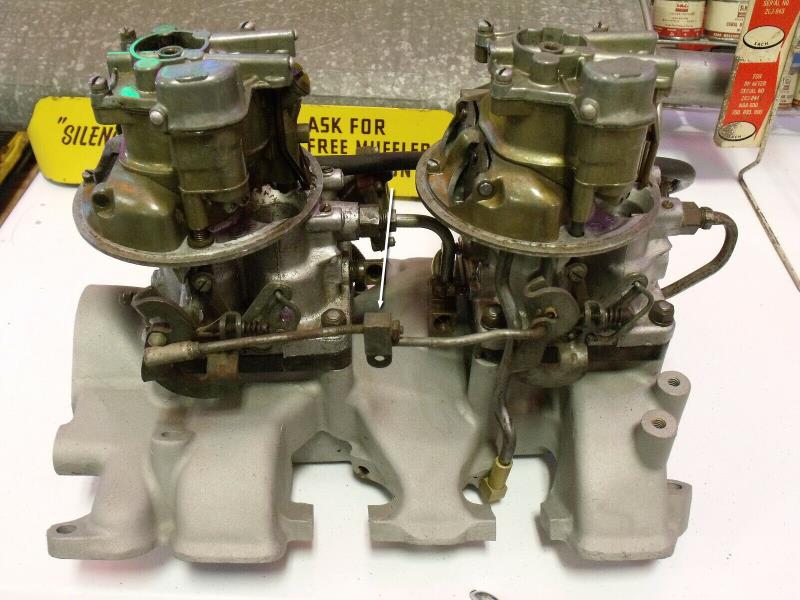
|
|
By Hoosier Hurricane - 6 Years Ago
|
|
Phil, if you are going to use those carbs facing forward on that manifold in a Bird, take the chrome trim from the hood scoop and slowly lower the hood closed while watching for interference with the fuel bowl on the front carb. The factory reversed the carbs to fix that problem, and your manifold looks to have the front carb further forward than the factory manifold. Air filter fit may also be a problem. Be careful, don't damage any parts of your Bird.
|
|
By Ted - 6 Years Ago
|
While I don’t have an immediate source for the oem Y dual quad linkages, I do end up fabricating most of what I need simply due to using a number of non-Ford intake manifolds with different center to center carb spacing. Factory linkage would have to be modified for those setups anyhow so making linkage from scratch is a better option for me. A progressive linkage setup can have you retrofitting the linkage from another engine or again making it all from scratch.
Here are some more pictures for ‘direct linkage’ hookup scenarios. Nothing says the linkage from the firewall has to connect between the center of the carbs. I’ve done setups that simply has the firewall linkage hooked to either the front or rear carb and then both carbs hooked together using the holes at the bottom of the carb bellcrank rather than at the top.
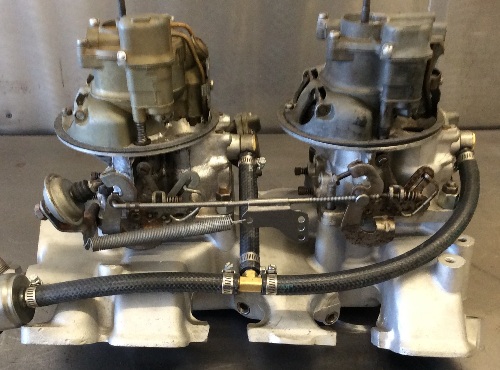
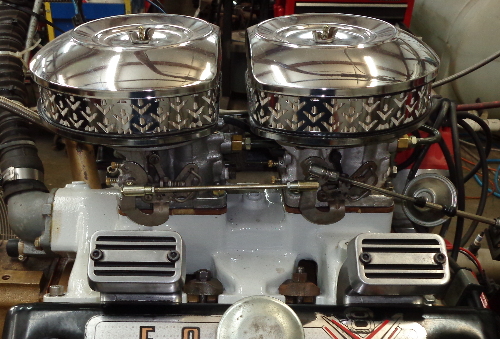
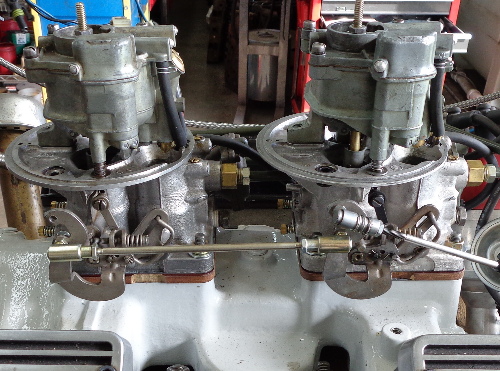
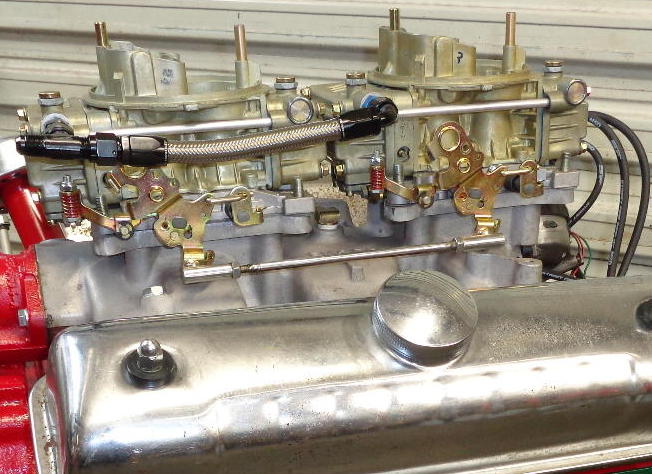
And here is a more detailed picture of the ‘clamp’ you were asking about earlier. It can be adjusted essentially anyway along the length of the linkage that hooks both carburetors together making it very adaptable to using existing firewall to carb linkage.
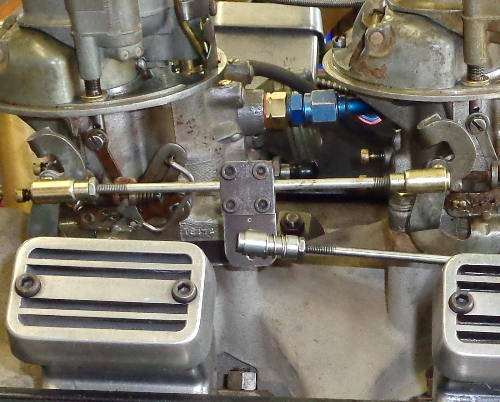
|
|
By Florida_Phil - 6 Years Ago
|
Got it. My next step is to test mount the dual quad manifold and carbs to check for hood clearance. There is a good possibility I may have to turn the carbs around backward or even mill the choke towers. From what I can tell so far, it looks like the carbs themselves will clear. The air cleaners will be the problem. Here's a photo of the Doane Spensor TBird. He had to modify the hood. I don't know what manifold he was using.
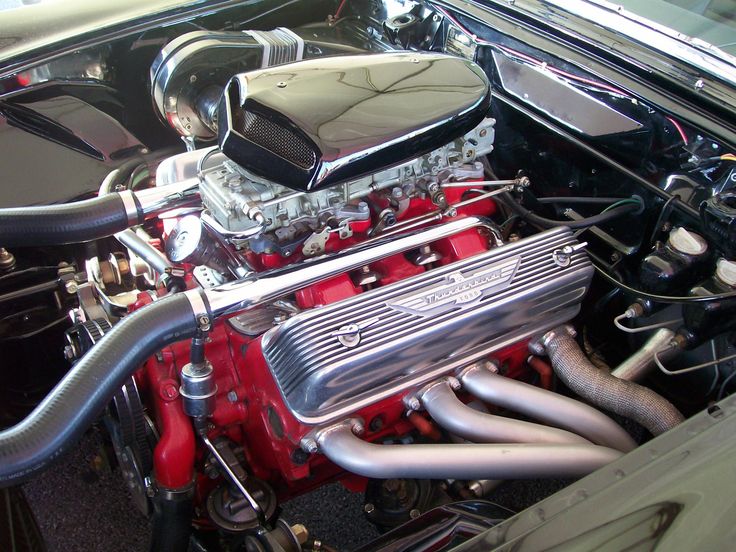
|
|
By KULTULZ - 6 Years Ago
|
|
I'm having a difficult time finding the part in the photo below. Lots of suppliers make a rod with ends to connect both carbs, The Thunderbird linkage requires a hole mid way. There is 8 3/4" between the carb linkage holes. Does anyone reproduce this linkage or must I fabricate it?
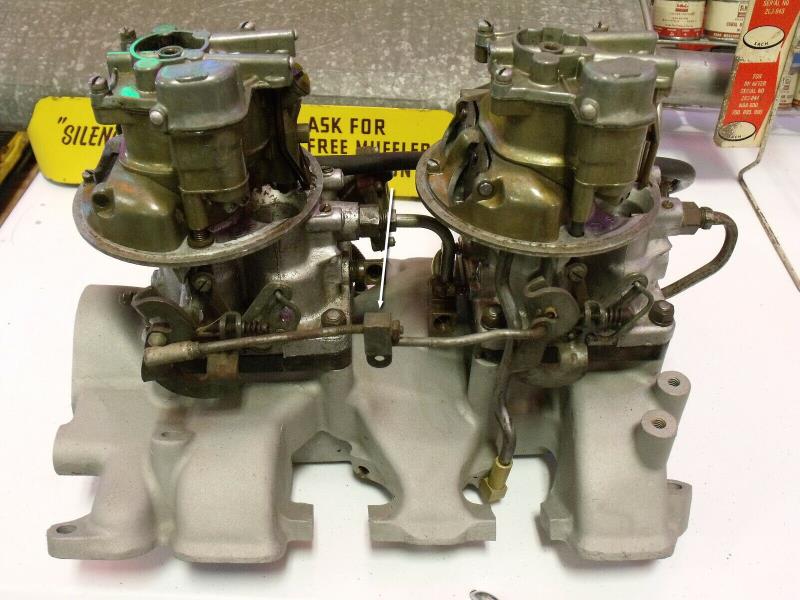
The part you show is part on an assembly - B7A 9747-E (ST) - B7A 9747-F (OD). It is for a 57 E-CODE ASSY only as the throttle rods would be too short for your carb spacing.
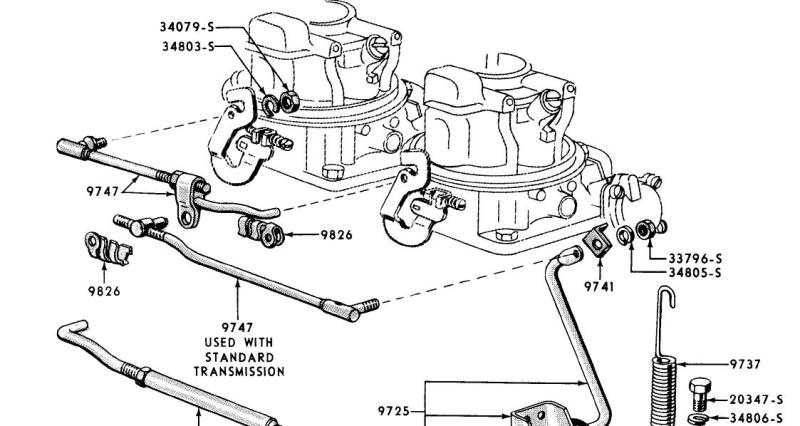
|
|
By NoShortcuts - 6 Years Ago
|
Ted. THANKS for correcting my earlier entry where I stated that the FE Fords with dual quads had direct throttle linkage rather than progressive throttle linkage.
QUESTION for all . . .
The Ford y-block production dual quad '56 Power Pack set-ups and the '57 E code dual quad set-ups using direct linkage were prone to Holley 4000 carburetor backfires and sometimes carburetor fires. I speculate the backfires were likely due to poor tune-up OR operator failure to adequately warm-up the engine before 'pushing it'. Carburetor backfires sometimes resulted in damage to or actual melting of the Holley 4000's zinc die cast primary venturi booster cluster with their brass donut rings.
Are carburetor backfires and carburetor fires less apt to occur when progressive throttle linkage is used with dual quad carburetor set-ups?
Thanks! 
|
|
By KULTULZ - 6 Years Ago
|
Maybe before worrying about linkage setups, you need to mount the intake and carbs for measuring hood clearance(s) as having to turn the carbs will require linkage modification(s).
Measure the carb pad throttle bores and if only 1.5", you will need an adapter(s) that has champfered throttle bore openings to accept the later HOLLEYS. And even if you mill the choke towers, you will need an air cleaner(s).
The EDEL intake you have was used for the 1956 MERC M260 option (8V) MGK-66005-AA if you need the reference.
|
|
By KULTULZ - 6 Years Ago
|
|
QUESTION for all . . .
The Ford y-block production dual quad '56 Power Pack set-ups and the '57 E code dual quad set-ups using direct linkage were prone to Holley 4000 carburetor backfires and sometimes carburetor fires. I speculate the backfires were likely due to poor tune-up OR operator failure to adequately warm-up the engine before 'pushing it'. Carburetor backfires sometimes resulted in damage to or actual melting of the Holley 4000's zinc die cast primary venturi booster cluster with their brass donut rings.
Are carburetor backfires and carburetor fires less apt to occur when progressive throttle linkage is used with dual quad carburetor set-ups?
I think the problem mainly was the design of the H4000 having the fuel bowl over the carb throttle body opening. Either a backfire, fuel leak or improper maintenance could set one off. I see no way style of linkage would have any effect (IMO).
|
|
By Ted - 6 Years Ago
|
|
Florida_Phil (1/1/2020)
... My next step is to test mount the dual quad manifold and carbs to check for hood clearance. There is a good possibility I may have to turn the carbs around backward or even mill the choke towers. From what I can tell so far, it looks like the carbs themselves will clear. The air cleaners will be the problem. ...
Correct me if I’m wrong on this but I’m thinking that the air cleaner placement stays the same on the 4150/4160 carbs regardless if they are facing forward or backwards. The air cleaner pad on the Teapot cars is offset which in effect doubles when reversing the carb direction but the air cleaner pads on the 4150/4160 carbs are centered.
If wanting to use the factory progressive linkage from the FE and SBF dual quad setups, then the carbs turned backwards would be the way to go for that. Keep in mind that the model 4160 Holley carbs will have ½” more clearance at the front bowl if turned backwards but that same ½” you save at the front ends up being ½” less between the rear bowl.
|
|
By NoShortcuts - 6 Years Ago
|
KULTULZ (1/1/2020)
QUESTION for all . . .
The Ford y-block production dual quad '56 Power Pack set-ups and the '57 E code dual quad set-ups using direct linkage were prone to Holley 4000 carburetor backfires and sometimes carburetor fires. I speculate the backfires were likely due to poor tune-up OR operator failure to adequately warm-up the engine before 'pushing it'. Carburetor backfires sometimes resulted in damage to or actual melting of the Holley 4000's zinc die cast primary venturi booster cluster with their brass donut rings.
Are carburetor backfires and carburetor fires less apt to occur when progressive throttle linkage is used with dual quad carburetor set-ups?
I think the problem mainly was the design of the H4000 having the fuel bowl over the carb throttle body opening. Either a backfire, fuel leak or improper maintenance could set one off. I see no way style of linkage would have any effect (IMO).
Kultulz. With the direct linkage of the carburetors, two carburetors are keeping the engine running at speed. Either of the two carburetors may be the source of the backfire. IF there is a backfire, the engine will continue to run at speed because the second carburetor will provide the air fuel mixture with it's throttle plates open. My thinking is that with the engine continuing to run at speed, it feeds a fire.
Going at my question another way, IF you're running progressive linkage with the dual quads, because the backfire of the single carburetor is not fed by as much air being drawn into the air cleaner by the engine still running at speed with the throttle plates of the second carb being virtually closed, is there less chance of a catastrophic fire?
|
|
By KULTULZ - 6 Years Ago
|
|
Kultulz. With the direct linkage of the carburetors, two carburetors are keeping the engine running at speed. Either of the two carburetors may be the source of the backfire. IF there is a backfire, the engine will continue to run at speed because the second carburetor will provide the air fuel mixture with it's throttle plates open. My thinking is that with the engine continuing to run at speed, it feeds a fire.
Going at my question another way, IF you're running progressive linkage with the dual quads, because the backfire of the single carburetor is not fed by as much air being drawn into the air cleaner by the engine still running at speed with the throttle plates of the second carb being virtually closed, is there less chance of a catastrophic fire?
I understand what you are saying and keep in mind I am no expert. I am a shade-tree and junkyard dog sort of person.
To me, such an event is caused by either a too lean fuel mixture or gasoline falling out of suspension (cold ambient air operation), poor/weak ignition components such as poor quality wires, defective cap, ign/curving and/or valve timing. On a race engine you want the mixture fat as gasoline is also a coolant and you want to CYA at high RPM. On a street engine, you want a leaner mixture to prevent plug/carbon fouling.
I see your concern with added air ingestion with multi-carb. The problem(s) I see is the H4000 fuel bowl placement. If you have a flash, it is in a stove.
One can use an O2 Sensor with gauge to monitor fuel mixture if you are not rich enough for a chassis dyno and exhaust gas analyzer time.
Hope I made sense ...
|
|
By KULTULZ - 6 Years Ago
|
Knew I would forget something.
Many racers run without an air cleaner. Besides ingesting filthy air, there is no flash suppressor. I have read accounts of the 8V H4000 having fires. Maybe this would possibly be a cause?
|
|
By Florida_Phil - 6 Years Ago
|
I never had any use for Holley 4000 carburetors. Back in the day, we called them "flaming infernos". With the fuel bowl up high like that, I can understand why. I understand why someone would want to keep an old car stock. I keep all the stock parts to my TBird in case a new owner might want to put them back on. It's quite a pile by now. I have had engine backfires with a Holley 4100 too. It wasn't the fault of the carburetor. Thankfully, I have never had one catch fire. I will say I have seen a lot of cars with scorched and bubbled hoods.
I have had all kinds of street and race cars in my life. One ran consistent 10.60 125 mph quarters. I have never had any carburetor perform better than a Holley. People tell me they leak. If you don't use quality gaskets they do. In my opinion, nothing feels better in the seat of your pants. To be honest, I have never owned a supercharged car and my drive around cars are all injected or turbo charged. As Warren Johnson once said, "You can't find a carburetor on a lawn mower these days". With a Holley, I know what to expect and they deliver.
|
|
By Lord Gaga - 6 Years Ago
|
"Back in the day" Whenever we encountered one of those Holley 4000's (we called 'em 'Helmet Heads') we threw them in the scrap pile! A bad design!NoShortcuts (1/1/2020)
Ted. THANKS for correcting my earlier entry where I stated that the FE Fords with dual quads had direct throttle linkage rather than progressive throttle linkage. QUESTION for all . . .The Ford y-block production dual quad '56 Power Pack set-ups and the '57 E code dual quad set-ups using direct linkage were prone to Holley 4000 carburetor backfires and sometimes carburetor fires. I speculate the backfires were likely due to poor tune-up OR operator failure to adequately warm-up the engine before 'pushing it'. Carburetor backfires sometimes resulted in damage to or actual melting of the Holley 4000's zinc die cast primary venturi booster cluster with their brass donut rings. Are carburetor backfires and carburetor fires less apt to occur when progressive throttle linkage is used with dual quad carburetor set-ups? Thanks! 
|
|
By FORD DEARBORN - 6 Years Ago
|
Greetings and a great new year to all: "Bach in the day," I made them work. I knew they functioned OK when everything was new and therefore could function OK again. With a good tune, a quality 4000 kit installed and adjusted properly, the 4000 was OK. Often it wasn't an option to install updated parts like a modern Holley and dual advanced distributor on someone's car I was repairing. As a kid I got a lot of satisfaction doing this in the 60's and was quite busy. However, my car or my buddies cars got the up-grades of what ever we could afford at the time.
|
|
By Florida_Phil - 6 Years Ago
|
"Back in my Day", no one that I knew had money. There weren't any doctors or lawyers living in my neighborhood. The first new car I ever sat in was my in-laws Olds 88 four door. When I hear today's politicians talk about income inequality it makes me laugh. No one gives you anything unless they want something in return, especially the government. We made do with what we had. We dragged home old cars just for the engines. A quick Gunk treatment and we were good to go. In the sixties when I graduated from high school the guys with money were construction workers making $6 an hour. Hard to believe that was big money back then.
I wouldn't trade anything for those memories. Like the day I blew up an engine when my coat hanger throttle linkage stuck wide open. Or the time I changed intake manifolds using Christmas lights for an extension cord. Or the time my best friend won the trophy at the local air port drag strip with a 56 Ford Y-Block when the 409 55 scruby he was running missed every gear there was.
Sorry for the nostalgia. It's a big part of the Y-Block experience.
|
|
By paul2748 - 6 Years Ago
|
I still run the stock 4000 on my 56 Bird. Had it redone by some one who knew what he was doing (not just some average guy who rebuilds carbs) and it runs fine. Ted converted it for me to run with a 57 distributor.
|
|
By Ted - 6 Years Ago
|
|
NoShortcuts (1/1/2020)
QUESTION for all . . .
The Ford y-block production dual quad '56 Power Pack set-ups and the '57 E code dual quad set-ups using direct linkage were prone to Holley 4000 carburetor backfires and sometimes carburetor fires. I speculate the backfires were likely due to poor tune-up OR operator failure to adequately warm-up the engine before 'pushing it'. Carburetor backfires sometimes resulted in damage to or actual melting of the Holley 4000's zinc die cast primary venturi booster cluster with their brass donut rings.
Are carburetor backfires and carburetor fires less apt to occur when progressive throttle linkage is used with dual quad carburetor set-ups?
Thanks!
Backfires from the dual quad Y engines was no more common than the rest of the engines from that era that used breaker point ignitions. The fire problem though was more notable with the Teapot carbs whether it was a single four or the dual quads than with the other carbs available back then. Part of that comes from the propensity of those carbs to leak fuel from either the large threaded screw that holds the needle and seat in place or the ‘O’ rings around the pair of secondary fuel transfer tubes. If either of the anti-siphon holes on the fuel reservoir cover stopped up, then the fuel would siphon down into the rear bowls when the engine was stopped. In the case of a backfire, then that puddle of fuel just ignited and burned.
I personally like those Holley model 2140 and 4000 carbs and with a modern ignition they are trouble free. A matching pair works really well on a dual quad setup simply due to them only being about 400 cfm each. Running just a single one typically has most engines under carbureted as even a 272 perks up when a larger carburetor is put on in place of a Teapot. The Teapot carbs can be picky to get the jetting just right with ethanol laden fuel though as the factory jetting was pretty much spot on with ‘pure’ gasoline. If you want to learn about carburetor circuitry, the 1953 & 1954 Holley model 2140 carbs are quite simple and the circuitry is easy to follow when tracing the fuel flows through them. Those model 2140 carbs are about 350 cfm so two of them on a mild Y with a dual quad setup makes for a spirited driver.
Here’s a picture of the 1953/1954 model 2140 carbs on a dual quad intake. Observe that the choke plate is actually located at the top of the venturie rather than at the front of an enclosure like the 1955-1957 model 4000 Teapot carbs.
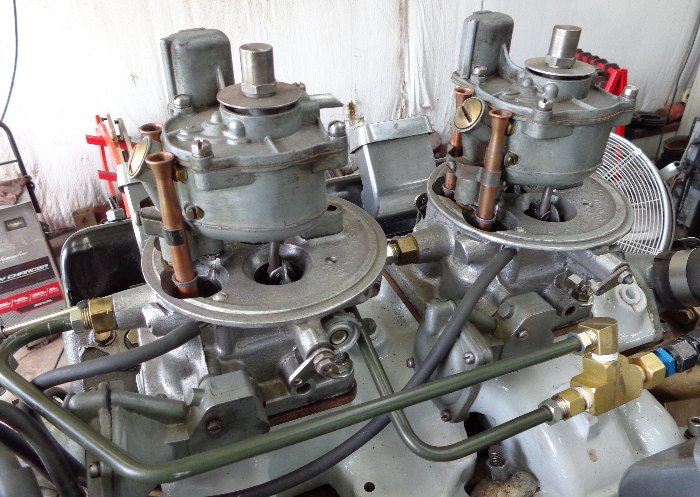
There’s also nothing wrong with the mid-Fifties GM Carter and Rochester 4V carbs on the dual quad setups but finding a matching pair is becoming more difficult. All carburetors are simply controlled fuel leaks where some just do a better of job of controlling those leaks than others.
|
|
By NoShortcuts - 6 Years Ago
|
This thread topic is emblematic of this Forum. Florida Phil's initial question has sparked multiple members to engage in a wide ranging discussion and exchange of related, in-depth, information.
Thanks to our sage moderators and members for all that you bring and share here. Like myself, I'm sure that many benefit from your wisdom, experience, efforts and generosity. Kudos to all! 
Best Wishes to all for a Happy and Healthy New Year!
Charlie
|
|
By Florida_Phil - 6 Years Ago
|
This forum is a great resource. Most of this information died with the people who raced, worked on and serviced these vehicles. The Internet lives forever.
|
|
By famdoc3 - 6 Years Ago
|
|
I have run dual quads on my T'bird since 1972. It took a while to get them right. Custom fabbing the linkage as I had no money to buy the T'bird linkage. On my last rebuild I milled a couple of adapters and mounted to G.M. Throttle bodies and fabbed up a new direct linkage running on the primaries of both. Rebuilt the throttle bodies, electric fuel pumps all to tolerate the ethanol in today's gas. Took a while to get the programming right on the accel gen 7 computer but it was all worth it. If I haven't driven the car Fo a few weeks still starts right up. It has wonderful low end response that it never had with the carbs, and with the air cleaner on it looks stock. Best of both worlds for the last 6-7 years.
|